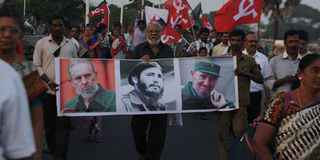How this country can immortalise Castro

Indian members of Communist Party of India carry placards bearing the image of former Cuban President Fidel Castro during a remembrance rally in Chennai on November 26, 2016. Castro set aside a park in the capital Havana dedicated to African heroes. PHOTO | AFP
What you need to know:
- But the inescapable fact is that these two gentlemen cemented their legacy and earned a place in the history books of the 20th Century and beyond.
- He provided free education and health to his people which enabled Cuba to attain a literacy rate of almost 100 per cent and is unparalleled anywhere in the world.
Cremated less than 24 hours after his death, the ashes of Fidel Castro will be interred at the Santa Ifigenia Cemetery today alongside his hero and fellow ideologue Jose Marti.
But, unlike Marti who died at the age of 42, Castro lived a rich and fulfilling life to die at 90.
Additionally, while Marti laid down the seeds of Cuban independence from Spanish rule before even Castro was born, Castro shaped the history of post-independence Cuba in a way that even Marti could not have dreamed of.
But the inescapable fact is that these two gentlemen cemented their legacy and earned a place in the history books of the 20th Century and beyond.
On November 29, on a balmy winter evening at the Revolution Square in Havana and under the watchful eyes of a life sized statue of Jose Marti, world leaders mostly from Latin America, Africa and Asia gathered to pay tribute to Fidel, as he was popularly known to his people.
Born in 1926, Fidel Castro Ruz gained power through a popular revolution in 1959 and governed Cuba under a strict socialist political system until 2008 when his younger brother, Raul Castro Ruz, succeeded him.
During this period, he created an integrated multi-racial society where all Cuban citizens were equal irrespective of race, creed or colour.
HELPING OTHERS
Using the foundation inspired by his close friend and revolutionary compatriot, Che Guevara, he provided free education and health to his people which enabled Cuba to attain a literacy rate of almost 100 per cent and is unparalleled anywhere in the world.
Having achieved this feat at home, Castro extended his policies of fighting for injustice and non-discrimination beyond the borders of Cuba especially to the African countries still under bondage by their colonial masters.
To this end, he sent his armies and military advisers to fight alongside the liberation groups of the southern African states of Mozambique, Angola, Namibia and South Africa.
Their military victories were in no small measure due to the assistance of Cuban soldiers and its military hardware.
Once these countries were liberated, he replaced his military personnel and advisers with medical doctors, researchers and epidemiologists and spread them all over Africa and the Caribbean to assist in eradicating killer tropical diseases which would in turn alleviate poverty.
He further opened his tertiary institutions to these countries by offering them generous scholarships to study medicine and engineering which would form a critical backbone in not only post liberated South African economies but other economies in Africa and beyond.
REMEMBERING CASTRO
The end of the Cold War and the crippling embargo by the USA reduced but did not halt altogether this generosity that continues up to the present day.
Kenya has, over the years, been a beneficiary of many scholarships in medicine and sports from Cuba and has numerous doctors dotted around the country both in the public and private sectors who are an attestation to this fact.
His love for the resistance struggle and the black race knew no bounds and so, when all the African countries were liberated, Castro set aside a park in the capital Havana dedicated to African heroes and where all the busts of leaders of the liberation struggle have pride of place.
The bust of Kenya’s independence hero and first President Mzee Jomo Kenyatta will, in April 2017, be the latest addition to this park.
How can we, as Kenyans, recognise this icon who defied all odds, was a leader of leaders, clearly loved the black race, outlived and thumped his nose at 10 American Presidents under a harsh and crippling economic embargo and lived and died under his own terms?
Nearer home, in 2008, the Caribbean-Community (Caricom) recognised Castro’s contribution to the Caribbean countries by awarding him its highest honour, the order of the Caribbean Community, the only non-Caricom citizen to whom it has been bestowed.
And early this year, President Obama became the first American President to visit Cuba in nearly a century and the first since a revolution led by Fidel Castro toppled a US-backed strongman in 1959.
It is my sincere hope that Kenya can immortalise a street or monument in the County of Nairobi to this icon who loved and did so much for Africa.
The writer is Kenya’s representative to Cuba.





